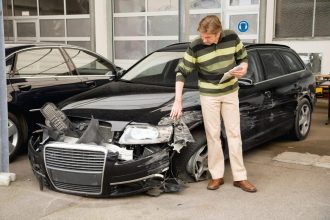Car accidents are notoriously common in this country. On some level, they’re inevitable; with millions of drivers on the road every day, it’s only a matter of time before two or more vehicles collide with each other.
But on another level, the problem is perplexing. The majority of car accidents involve some degree of negligence from at least one driver, and negligence is ostensibly preventable.
Why is it that negligence is so common in car accidents?
What Is Negligence?
Negligence is a legal term – and an important one in the realm of personal injury law. Essentially, negligence is a failure to comply with an implied duty that we all have to act with care with respect to other persons and their property. If you cut out the legal jargon, negligence is acting carelessly.
In the legal world, there is a precise formula that lawyers must follow in order to prove negligence. But colloquially, we can deem an act or the omission of an act negligent when a reasonable person acting with care would have done the opposite. As a simple example, a responsible business owner would mitigate ice on their sidewalks, while a negligent business owner would fail to address it, making it more likely that someone might slip and fall on that ice.
With respect to car accidents, we should also acknowledge the legal concept of negligence per se, which allows the automatic inference of negligence when a person violates a statute meant to keep people safe. For example, if the legal speed limit in an area is 35 mph, and you cause an accident by going 50 mph, you’ll automatically be found to be negligent in the absence of any mitigating circumstances.
The Causes of Car Accidents
Human error is the leading cause of car accidents. This should be relatively unsurprising, since humans are the ones responsible for operating these vehicles. There are many types of human errors responsible for car accidents, including:
Recognition errors. A recognition error is a failure to see or identify something important. For example, you may not notice that a traffic light has turned red, or you may not notice that another driver in front of you has suddenly stopped.
Decision errors. A decision error is a poor decision while driving. For example, you might deliberately choose to weave between lanes in an effort to get ahead of a slow pack of drivers.
Performance errors. A performance error is a mistake in execution, such as overcorrecting in response to the sudden introduction of an obstacle in the road.
As you can already see, there are many opportunities for drivers to operate negligently.
Examples of Negligence While Driving
These are some more concrete examples of negligence when driving:
Speeding. Even if everyone else is doing it, traveling in excess of the speed limit is a violation of the law and a form of negligence. Speed limits exist for a reason.
Failure to obey signs/warnings. Sometimes, we fail to obey warning signs because we don’t take them seriously or because no one else is around. Other times, we simply don’t notice them. Either way, disregarding these signs and warnings is a negligent act.
Distraction. Distracted driving is extremely unsafe, killing thousands of people every year. Even the simple act of changing the radio or drinking your coffee can be a meaningful enough distraction to cause an accident.
Intoxication. We all know that intoxicated driving is dangerous, but some people still insist on doing it, sometimes because they fail to recognize their own intoxication level.
Driving while tired. Driving while tired can be similarly negligent, though it’s viewed as a less severe offense (for obvious reasons).
Failure to account for bad weather. If the weather is bad, a responsible driver should attempt to accommodate it by driving more slowly and carefully. Not all of us do this all of the time.
We Are All Negligent
Ultimately, we are all negligent drivers, at least occasionally. If you think you’ve never been negligent while driving, you probably haven’t been paying close attention to your own habits and behaviors. Taking your eyes off the road even for a moment and traveling above the speed limit are just a couple of examples of negligent activities that most of us do regularly – and in some ways, the fact that these actions haven’t led to car accidents is a matter of luck.
The Bottom Line
The bottom line here is that negligence is a common primary cause of car accidents, in part because without negligent activity, there wouldn’t be many opportunities for car accidents to happen. We are all negligent from time to time, usually in minor ways, but even a minor act of negligence can ultimately cause a car accident. We owe it to ourselves and each other to do our best to remain safe on the roads.













